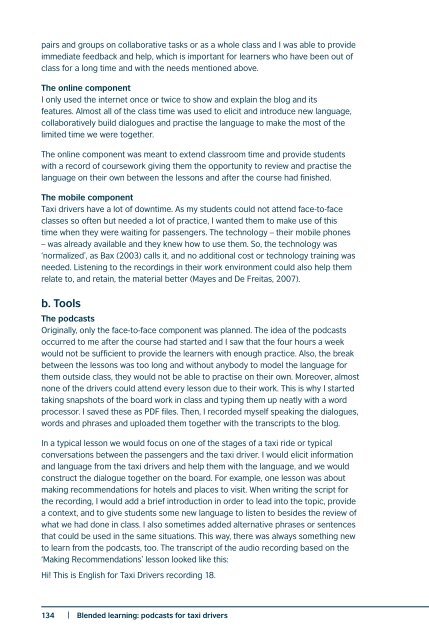Blended Learning in English Language Teaching: Course Design and Implementation
Blended Learning in English Language Teaching: Course Design and Implementation
Blended Learning in English Language Teaching: Course Design and Implementation
Create successful ePaper yourself
Turn your PDF publications into a flip-book with our unique Google optimized e-Paper software.
pairs <strong>and</strong> groups on collaborative tasks or as a whole class <strong>and</strong> I was able to provide<br />
immediate feedback <strong>and</strong> help, which is important for learners who have been out of<br />
class for a long time <strong>and</strong> with the needs mentioned above.<br />
The onl<strong>in</strong>e component<br />
I only used the <strong>in</strong>ternet once or twice to show <strong>and</strong> expla<strong>in</strong> the blog <strong>and</strong> its<br />
features. Almost all of the class time was used to elicit <strong>and</strong> <strong>in</strong>troduce new language,<br />
collaboratively build dialogues <strong>and</strong> practise the language to make the most of the<br />
limited time we were together.<br />
The onl<strong>in</strong>e component was meant to extend classroom time <strong>and</strong> provide students<br />
with a record of coursework giv<strong>in</strong>g them the opportunity to review <strong>and</strong> practise the<br />
language on their own between the lessons <strong>and</strong> after the course had f<strong>in</strong>ished.<br />
The mobile component<br />
Taxi drivers have a lot of downtime. As my students could not attend face-to-face<br />
classes so often but needed a lot of practice, I wanted them to make use of this<br />
time when they were wait<strong>in</strong>g for passengers. The technology – their mobile phones<br />
– was already available <strong>and</strong> they knew how to use them. So, the technology was<br />
‘normalized’, as Bax (2003) calls it, <strong>and</strong> no additional cost or technology tra<strong>in</strong><strong>in</strong>g was<br />
needed. Listen<strong>in</strong>g to the record<strong>in</strong>gs <strong>in</strong> their work environment could also help them<br />
relate to, <strong>and</strong> reta<strong>in</strong>, the material better (Mayes <strong>and</strong> De Freitas, 2007).<br />
b. Tools<br />
The podcasts<br />
Orig<strong>in</strong>ally, only the face-to-face component was planned. The idea of the podcasts<br />
occurred to me after the course had started <strong>and</strong> I saw that the four hours a week<br />
would not be sufficient to provide the learners with enough practice. Also, the break<br />
between the lessons was too long <strong>and</strong> without anybody to model the language for<br />
them outside class, they would not be able to practise on their own. Moreover, almost<br />
none of the drivers could attend every lesson due to their work. This is why I started<br />
tak<strong>in</strong>g snapshots of the board work <strong>in</strong> class <strong>and</strong> typ<strong>in</strong>g them up neatly with a word<br />
processor. I saved these as PDF files. Then, I recorded myself speak<strong>in</strong>g the dialogues,<br />
words <strong>and</strong> phrases <strong>and</strong> uploaded them together with the transcripts to the blog.<br />
In a typical lesson we would focus on one of the stages of a taxi ride or typical<br />
conversations between the passengers <strong>and</strong> the taxi driver. I would elicit <strong>in</strong>formation<br />
<strong>and</strong> language from the taxi drivers <strong>and</strong> help them with the language, <strong>and</strong> we would<br />
construct the dialogue together on the board. For example, one lesson was about<br />
mak<strong>in</strong>g recommendations for hotels <strong>and</strong> places to visit. When writ<strong>in</strong>g the script for<br />
the record<strong>in</strong>g, I would add a brief <strong>in</strong>troduction <strong>in</strong> order to lead <strong>in</strong>to the topic, provide<br />
a context, <strong>and</strong> to give students some new language to listen to besides the review of<br />
what we had done <strong>in</strong> class. I also sometimes added alternative phrases or sentences<br />
that could be used <strong>in</strong> the same situations. This way, there was always someth<strong>in</strong>g new<br />
to learn from the podcasts, too. The transcript of the audio record<strong>in</strong>g based on the<br />
‘Mak<strong>in</strong>g Recommendations’ lesson looked like this:<br />
Hi! This is <strong>English</strong> for Taxi Drivers record<strong>in</strong>g 18.<br />
134 | <strong>Blended</strong> learn<strong>in</strong>g: podcasts for taxi drivers


